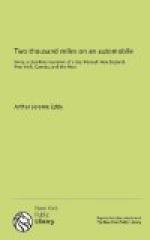A single-cylinder motor possesses a few great advantages to compensate for many disadvantages; it has fewer parts to get out of order, and troubles can be much more quickly located and overcome. Two, three, and four cylinders run with less vibration and are better in every way, except that with every cylinder added the chances of troubles are multiplied, and the difficulty of locating them increased. Each cylinder must have its own lubrication, its ignition, intake, and exhaust mechanisms,—the quartette that is responsible for nine-tenths of the stops.
Beyond eight or ten horse-power the single cylinder is hardly practicable. The kick from the explosion is too violent, the vibration and strain too great, and power is lost in transmission. But up to eight or ten horse-power the single-cylinder motor with a heavy fly-wheel is practicable, runs very smoothly at high speeds, mounts hills and ploughs mud quite successfully. The American ten horse-power single-cylinder motor will go faster and farther on our roads than most foreign double-cylinder machines of the same horse-power. It will last longer and require less repairs.
The amateur who is not a pretty good mechanic and who wishes to tour without the assistance of an expert will do well to use the single-cylinder motor; he will have trouble enough with that without seeking further complications by the adoption of multiple cylinders.
It is quite practicable to attain speeds of from twenty to thirty miles per hour with a single-cylinder motor, but for bad roads and hilly countries a low gear with a maximum of twenty to twenty-five miles per hour is better. The average for the day will be higher because better speed is maintained through heavy roads and on up grades.
So far as resiliency is concerned, there is no comparison between the French double-tube tire and the heavy American single tube, —the former is far ahead, and is, of course, easily repaired on the road, but it does not seem to stand the severe wear of American roads, and it is very easily punctured. Our highways both in and out of cities are filled with things that cut, and bristle with wire-nails. The heavy American single-tube tire holds out quite well; it gets many deep cuts and takes nails like a pin-cushion, but comparatively few go through. The weight of the tire makes it rather hard riding, very hard, indeed, as compared with a fine Michelin.
There are many devices for carrying luggage, but for getting a good deal into a small compass there is nothing equal to a big Scotch hold-all. It is waterproof to begin with, and holds more than a small steamer-trunk. It can be strapped in or under the machine anywhere. Trunks and hat-boxes may remain with the express companies, always within a few hours’ call.
What to wear is something of a problem. In late autumn and winter fur is absolutely essential to comfort. Even at fifteen or twenty miles an hour the wind is penetrating and goes through everything but the closest of fur. For women, fur or leather-lined coats are comfortable even when the weather seems still quite warm.




